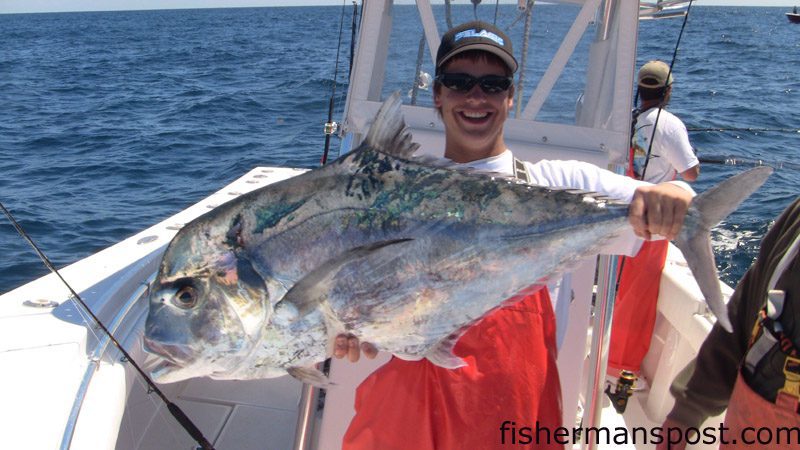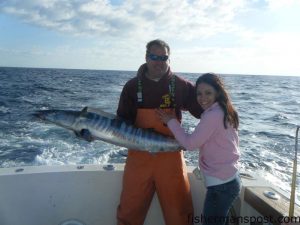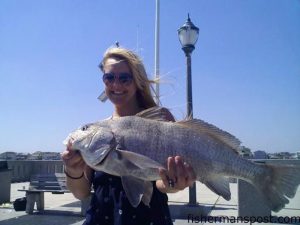Wrightsville Beach April 14, 2011

Zach Messer with a 30 lb. African pompano that fell for a Nasout jig while he was fishing the break 60 miles off Wrightsville Beach with Capt. Rick Croson of Living Waters Guide Service.
Chip, of Tex’s Tackle, reports that the Gulf Stream bite is still solid when the weather lets boats make a run to the break. Trollers are connecting with wahoo, blackfin tuna, and a few yellowfins in the blue water, both while dragging high-speed lures and skirted ballyhoo.
Vertical jiggers are still finding plenty of action with large amberjacks while working structure along the break. Some cobia, African pompano, and bottomfish are also falling for the jigs. Slightly further offshore, jigging for blackfin tuna around bait and fish marks has been very productive of late.
The commercial fleet found good king mackerel action in the 30 mile range last week, so the fish should be moving on in from their offshore wintering grounds. Frying Pan Tower should be a good place to begin a search for kings for the remainder of April.
Atlantic bonito haven’t made their much-anticipated appearance yet, but with nearshore water temperatures at 60+ degrees, it won’t be long until they’re chasing bait at structure within 10 miles of the beaches. Trolling Yo-Zuri Deep Divers and casting small metal jigs to feeding schools of fish is the best way to connect with the bonito.
Inshore, the red drum bite has been solid in the creeks, on the flats, and in the surf. A variety of artificial and natural baits will fool the reds.
Flounder are beginning to make their springtime appearance in the area, and they will only get more numerous and hungry as the month wears on and the water temperatures continue to climb.
Jon, of Intracoastal Angler, reports that the red drum bite is still excellent inshore. Most of the action has been in the creeks, on the shallow flats, and around ICW docks and other structure (where good numbers of black drum are mixed in) recently. Gulp baits and a variety of other lures will fool the reds, and fresh shrimp should bring attention as well from black drum around the waterway structure.

Patrick Horning and Simone Payne with Payne's first wahoo, which fell for a skirted ballyhoo near the Same Ol' Hole while they were fishing with Capt. Paul Horning on the Salty Seaman.
Some flounder are beginning to show up inshore, and anglers are catching a few while hunting the reds.
Anglers are still catching and releasing some striped bass in the Cape Fear River, though the bite is hit-or-miss when compared to the cooler months. The warmer water temperatures do have the fish a little more aggressive, though, and some anglers have been connecting with them on topwater plugs lately.
Offshore, the Gulf Stream fishing remains solid, and boats trolling skirted ballyhoo are hooking up with wahoo, blackfin tuna, and a few yellowfins. Anglers vertically jigging are also enjoying some success with the blackfins.
Rick, of Living Waters Guide Service, reports that anglers are still finding fast action with large amberjacks and almaco jacks while jigging structure along the break. Some cobia and African pompano are in the mix as well.
Offshore of the break, anglers are connecting with some blackfin tuna while working jigs over bait and fish marking on the depthfinder. Wahoo are also in the area and attacking jigs and trolled baits.
Jim, of Plan 9 Charters, reports that bluefish have shown up in force on nearshore structure within 5 miles of the beaches. They’ll attack just about anything, but small metal jigs like Stingsilvers are one of the easiest and most fun ways to hook up.
Plenty of large black sea bass are feeding on the same structures, but they’re closed to harvest so it’s a catch-and-release fishery at present.

Megan Hahne, of Wilmington, with her first black drum, an 8 lb., 14 oz. fish that fell for a dead shrimp beneath Johnnie Mercer's Pier.
Rick, of Rod-Man Charters, reports that black and red drum are in a typical springtime pattern, feeding around docks and other structure in the ICW between Wrightsville and Carolina beaches. Fresh shrimp on bottom rigs are the most effective bait at fooling both species this early in the year.
Brandon, of Johnnie Mercer’s Pier, reports that anglers are catching decent numbers of sea mullet, pufferfish, and small croakers while bottom fishing with shrimp. A few black drum (to 8-9 lbs.) are in the mix as well, along with plenty of dogfish.
The water is 62 degrees.
